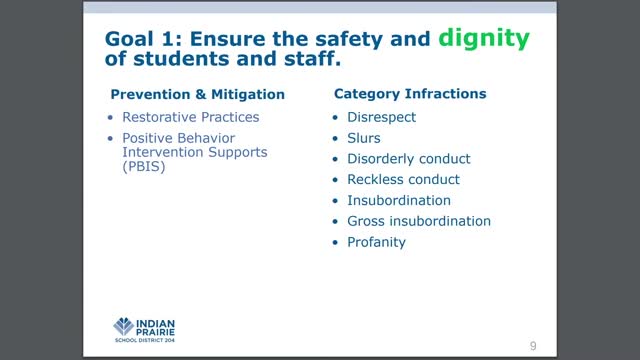Educators tackle student trauma to improve behavior and learning
August 21, 2024 | Indian Prairie CUSD 204, School Boards, Illinois
This article was created by AI summarizing key points discussed. AI makes mistakes, so for full details and context, please refer to the video of the full meeting. Please report any errors so we can fix them. Report an error »

During a recent government meeting, educators emphasized the importance of understanding student behavior as a form of communication, particularly in the context of trauma and adverse childhood experiences. The discussion highlighted that many students arrive at school with backgrounds that influence their reactions and coping mechanisms. The goal, as articulated by the speakers, is to equip students not only with academic skills in reading and math but also with emotional management strategies essential for success both in school and in life.
Data presented during the meeting revealed that over 98% of students met behavior expectations aimed at ensuring the dignity of both students and staff. For the small percentage of students who did not meet these expectations, administrators are employing thoughtful approaches to address individual circumstances and promote growth.
The meeting also outlined several key goals for maintaining a safe and conducive learning environment. The first goal focuses on ensuring a weapons-free and drug-free school atmosphere, with data indicating minimal incidents related to these issues. Furthermore, the discussion noted that over 99% of students are making responsible choices regarding the safety of school property and the property of others.
A significant portion of the meeting was dedicated to addressing the root causes of student misbehavior. Faculty members, including deans, counselors, and social workers, are actively engaged in understanding and mitigating these issues, particularly at the high school level. This comprehensive approach underscores the commitment to fostering a supportive educational environment that prioritizes both safety and emotional well-being.
Data presented during the meeting revealed that over 98% of students met behavior expectations aimed at ensuring the dignity of both students and staff. For the small percentage of students who did not meet these expectations, administrators are employing thoughtful approaches to address individual circumstances and promote growth.
The meeting also outlined several key goals for maintaining a safe and conducive learning environment. The first goal focuses on ensuring a weapons-free and drug-free school atmosphere, with data indicating minimal incidents related to these issues. Furthermore, the discussion noted that over 99% of students are making responsible choices regarding the safety of school property and the property of others.
A significant portion of the meeting was dedicated to addressing the root causes of student misbehavior. Faculty members, including deans, counselors, and social workers, are actively engaged in understanding and mitigating these issues, particularly at the high school level. This comprehensive approach underscores the commitment to fostering a supportive educational environment that prioritizes both safety and emotional well-being.
View full meeting
This article is based on a recent meeting—watch the full video and explore the complete transcript for deeper insights into the discussion.
View full meeting
